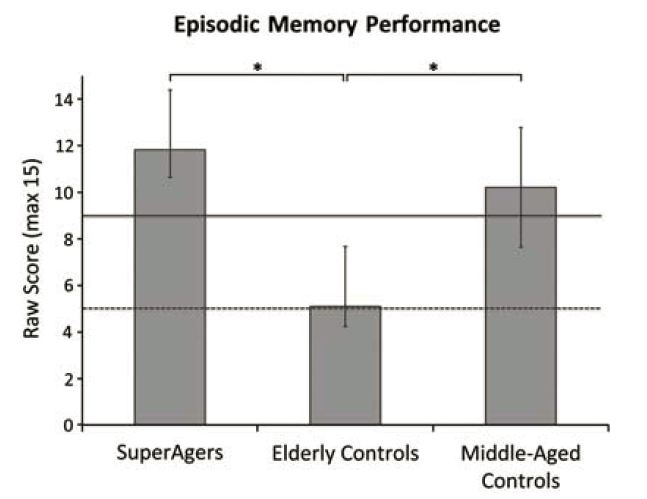Secrets of ‘SuperAger’ brains
August 20, 2012

Memory performance on a word list, showing the SuperAgers performed significantly better than elderly controls. The solid and dotted lines represent the average normative values for a 60-year-old and an 80-year-old. (Credit: Theresa M. Harrison, et al./Journal of the International Neuropsychological Society)
Northwestern Medicine researcher Emily Rogalski and associates have identified an elite group of elderly people age 80 and older whose memories are as sharp as people 20 to 30 years younger than them.
And on 3-D MRI scans, the SuperAger participants’ brains appear as young — and one brain region was even bigger — than the brains of the middle-aged participants.
Thicker cortex
She was astounded by the vitality of the SuperAgers’ cortex. Theirs was much thicker than the cortex of the normal group of elderly 80 and older (whose showed significant thinning) and closely resembled the cortex size of participants ages 50 to 65, considered the middle-aged group of the study.
“These findings are remarkable given the fact that grey matter or brain cell loss is a common part of normal aging,” said Rogalski, the principal investigator of the study and an assistant research professor at the Cognitive Neurology and Alzheimer’s Disease Center at Northwestern University Feinberg School of Medicine.
By measuring the thickness of the cortex — the outer layer of the brain where neurons (brain cells) reside — Rogalski has a sense of how many brain cells are left.
“We can’t actually count them, but the thickness of the outer cortex of the brain provides an indirect measure of the health of the brain,” she said. “A thicker cortex, suggests a greater number of neurons.”
In another region deep in the brain, the anterior cingulate of SuperAger participants’ was actually thicker than in the 50 to 65 year olds.
“This is pretty incredible,” Rogalski said. “This region is important for attention. Attention supports memory. Perhaps the SuperAgers have really keen attention and that supports their exceptional memories.”
To be defined as a SuperAger, the participants needed to score at or above the norm of the 50 to 65 year olds on memory screenings.
By identifying older people who seem to be uniquely protected from the deterioration of memory and atrophy of brain cells that accompanies aging, Rogalski hopes to unlock the secrets of their youthful brains. Those discoveries may be applied to protect others from memory loss or even Alzheimer’s disease.
“By looking at a really healthy older brain, we can start to deduce how SuperAgers are able to maintain their good memory,” Rogalski said. “Many scientists study what’s wrong with the brain, but maybe we can ultimately help Alzheimer’s patients by figuring out what goes right in the brain of SuperAgers. What we learn from these healthy brains may inform our strategies for improving quality of life for the elderly and for combatting Alzheimer’s disease.”
This project was supported by The Davee Foundation and the National Institute on Aging of the National Institutes of Health.